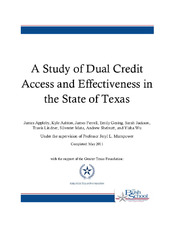| dc.description.abstract | In 2010, with the support of the Greater Texas Foundation (GTF), the Bush School of Government and Public Service at Texas A&M University initiated a study of dual credit opportunities in the state of Texas. Through a Capstone course directed by Prof. Jeryl L. Mumpower, Director of the Master of Public Service and Administration Program, this group was charged with analyzing and presenting data related to both the degree of access to dual credit resources throughout Texas, as well as the effectiveness of dual credit opportunities by type. The Greater Texas Foundation further charged the Capstone group with examining the dual credit opportunities for minority, low-income, and rural populations. Throughout a year-long course of study, the Capstone team worked to collect data regarding these issues. We hope that this study will provide a valuable resource for our client, the Greater Texas Foundation, as well as for researchers and practitioners in Texas and throughout the nation.
In examining dual credit in the state of Texas, the Capstone team identified seven research questions of particular interest to GTF, falling within two topic areas: access to dual credit and the effectiveness of current dual credit programs.
Access to Dual Credit Programs
1. Where are dual credit programs available in the state of Texas?
2. How many students participate in dual credit programs?
3. What is the level of participation for rural, economically disadvantaged, and minority students?
4. What factors affect whether students participate in dual credit courses?
Effectiveness of Dual Credit Programs
5. How does postsecondary performance of dual credit participants compare to students who didn‘t participate in dual credit programs?
6. Do certain high schools have dual credit programs with graduates who fare better than those from other programs?
7. Which dual credit models have the best rates of postsecondary enrollment and graduation among their graduates?
This study has involved two primary efforts. The first was an extensive review of relevant literature to provide a thorough backdrop for analyses of the Texas situation. The second was original analyses of data collected and compiled by members of the Bush School Capstone team. | en |


